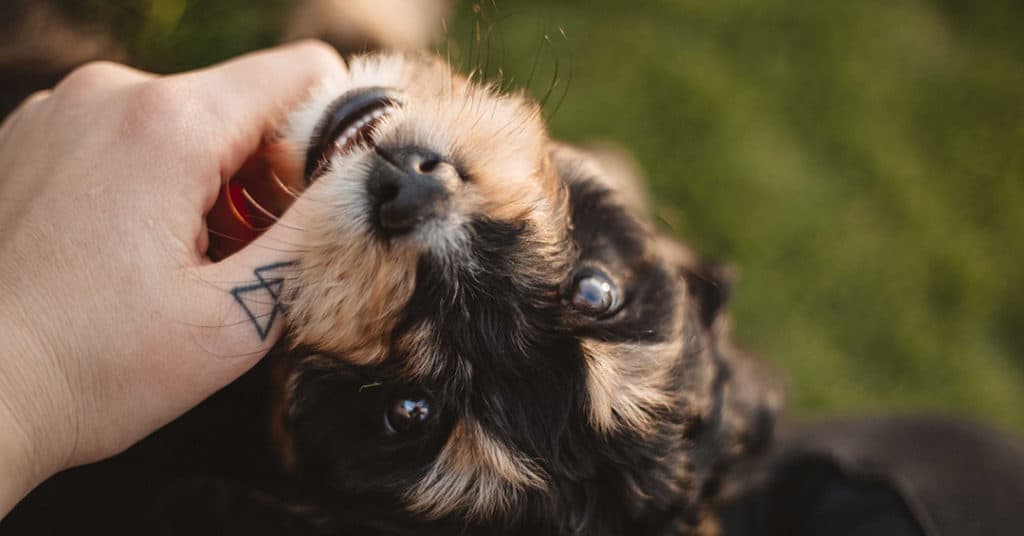
Bernedoodles are adorable, friendly and intelligent dogs, which is no surprise since you’re mixing the friendly, playful Bernese Mountain Dog with the intelligent Poodle. Unlike many other dog breeds, there is not a one size fits all because Bernedoodles come in a variety of different sizes.
The Bernese Mountain Dog ranges from 80 – 110 pounds, and Poodles are a variety of sizes; from the Toy Poodle at under 10 pounds to a Standard Poodle which can be up to 70 pounds.
How big do Bernedoodles get?
- STANDARD Bernedoodles are 50+ pounds, though they are usually in the range of 70 to 90 pounds when fully mature. They measure about 23” to 29” around at the shoulders.
- MINIATURE Bernedoodles range from 25 to 49 pounds and measure between 18” and 22” at the shoulders.
- TINY, MICRO, TOY Bernedoodles – Grow to be between 10 and 24 pounds and measure from 12” to 17” around at the shoulders.
| Height | Weight | |
| STANDARD | 23 – 29 Inches at the Shoulder | 70 – 90 Pounds |
| MINIATURE | 18 – 22 Inches at the Shoulder | 25 – 49 Pounds |
| TINY/MICRO/TOY | 12 – 17 Inches at the Shoulder | 10 – 14 Pounds |
Bernedoodle sizes depend on their genetics and their parents. The females are often smaller than the males. The largest factor determining the size of the Bernedoodle is which size Poodle the Bernese Mountain Dog is mated with.
Breeding Process To Achieve Size Variations
The size Bernedoodle a dog will be at birth and as an adult depends on the breeding. Bernese Mountain Dogs are all the same size, but Poodles are not. Bernedoodles come in three different sizes because there are three different sizes of Poodles that may be used in the mating.
As stated above, miniature Bernedoodles are the result of mating the Bernese Mountain Dog with the Miniature Poodle. Tiny Bernedoodles are produced by mating Tiny Poodles with the Bernese Mountain Dog, and Mini Bernedoodles are produced by mating Miniature Poodles with Bernese Mountain Dogs. Bernedoodles even smaller than the Miniature Bernedoodle can even be produced by mating with the right dogs. This is often done through generational breeding.
This breeding process may sound fairly straight forward, but it’s done for more reasons than just to produce a certain size dog. It’s often done to produce a specific dog with specific qualities that can improve the bloodline or give buyers the exact dog they want. A buyer interested in an energetic dog might want one that was Bernese mixed with the tiny or miniature Poodle.
What Age Is A Bernedoodle Full Grown?
Determining the age at which the Bernedoodle is considered as full-grown can be difficult for a few reasons. The first reason is that each dog is different; the second reason is that Bernedoodles come in different sizes. Living circumstances and nutrition can also affect a dog’s growth. Just when you think your Bernedoodle is done growing, you’ll find out he’s a few pounds heavier and a couple of inches taller.
Like most dogs, the Bernadoodle may have the outward appearance (but not the personality) of an adult dog at about one year of age, but they are not done growing. Little dogs like the Chihuahua are often full grown at the age of one while a large dog like the Labrador Retriever doesn’t reach full adult size until they reach the age of two. Medium size dogs like Border Collies reach their full adult size at about 15 months of age.
So, what category does the Bernedoodle fall into? This is an interesting question because the Bernese Mountain dog may be mated with a tiny, miniature or standard poodle, which will definitely play some role in not only what their adult size will be but when they’ll reach it. When Bernedoodles are the topic, they’re usually in the category standard size, and most breeders claim that Doodle dogs, the group of which Bernedoodles are part of, are fully grown between the age of two and 2 ½.
Generations & Benefits
Bernedoodles and other Doodle dogs are hybrid dogs created by mating two mixed breed dogs together. They do this to produce a dog that possesses the best qualities of each breed and the healthiest version of that dog. The breeders don’t stop at just mating one breed to another. To further fine-tooth theses hybrid or designer dogs, they’ve developed generation breeding. Generation breeding is used for a couple of different purposes.
Just breeding one breed of dog to another breed of dog does not make a designer or new breed of dog. It has to go further into the generations. One of the main benefits of generation breeding is that breeders are able to get the best qualities out of one dog and hope that this quality shows up in the litter. Generation breeding is also used to improve the health of the two breeds. Every dog breed is prone to some kind of health issue, and the Poodle and Bernese Mountain Dog are no exception to that.
Say that the Poodle is prone to ten different diseases, and the Bernese Mountain Dog is also prone to developing ten different diseases. This is not to say they will develop these diseases, just that they are prone to getting them. Chances are very slim that both dogs are prone to developing the same ten diseases. By breeding these two dogs, they’re decreasing the chances of these dogs developing many of the diseases and making a healthier breed in the process. One of the largest benefits of generational breeding with Bernedoodles is the ability to make them as allergy-friendly as possible, which is one of the biggest attractions to these dogs.
Although the F1 Bernedoodle is typically the most expensive of the Bernedoodles, those that are the result of further generational breeding are often the ones called the designer dogs because the breeders are able to get more of one breed into the bloodline to improve the bloodline of this new dog breed. Generation breeding enables experienced breeders to determine the size, coat and even color or future litters. Here is how the generational breeding works.
- F1 – This puppy is the result of mating between a Poodle and a Bernese Mountain Dog. This dog is 50% Poodle and 50% Bernese Mountain Dog.
- F1b – This puppy is the result of mating an F1 Bernedoodle with a Poodle. This dog is 75% Poodle and 25% Bernese Mountain Dog.
- F2 – This is the result of mating two F1 Bernedoodles together. This dog is 50% Poodle and 50% Bernese Mountain Dog.
One of the main purpose of Doodle dogs like the Bernedoodle is to produce dogs that are allergy-friendly while still possessing the qualities people want in a dog: friendly, loyal, intelligent, playful and loving. This is exactly what you get with a Bernedoodle. Experimenting with generational breeding also allows the breeder to get the best allergy-friendly attributes.
Are Activity Level & Temperament Affected By Size?
As a rule, the Miniature and Tiny Bernedoodles have a higher energy drive than the standard Bernedoodles. This usually stems from the Poodles side of the family because Mini and Toy Poodles also have a higher energy drive than standard Poodles. To overcompensate for this difference, breeders often choose calm poodles to mate with the Bernese Mountain Dog in an attempt to produce docile and calmer Bernedoodles. Generally, the lower the energy drive, the calmer the dog is going to be. The Standard Bernedoodles usually have a more mellow temperament than the tiny and miniature Bernedoodles.
Related Questions
What is the life expectancy of a Bernedoodle?
The life expectancy of Bernedoodles can vary depending on the size of the dog. Typically, the smaller the dog, the longer its life span. Standard Bernedoodles have a life expectancy of 12-15 years while miniature Bernedoodles can live to be 17, and toy Bernedoodles can live to be 18 years or more.
How much attention do Bernedoodles need?
Bernedoodles are friendly loving dogs that want and need attention especially when they’re young puppies. They can be stubborn and headstrong when they feel strongly about something. If they don’t get enough attention or socializing, they can become shy and withdrawn. Unlike many dogs that need their own personal space at times, Bernedoodles love nothing more than sitting by your side and getting all your attention as much as possible. They also need consistent training from the time they’re young. They are very intelligent animals but need to be taught what is expected of them.
Final Thoughts
Bernedoodles possess so many wonderful qualities. They have the intelligence, playfulness and low-shedding qualities of the Poodle with the loyalty and excellent temperament of the Bernese Mountain Dog. Getting a Bernedoodle dog is getting one dog with the best qualities of two other superior dog breeds. Adding to the attraction is the ability, with careful breeding, to get a Bernedoodle in the size, coat and color you! Talk about hand-picking your dog!




